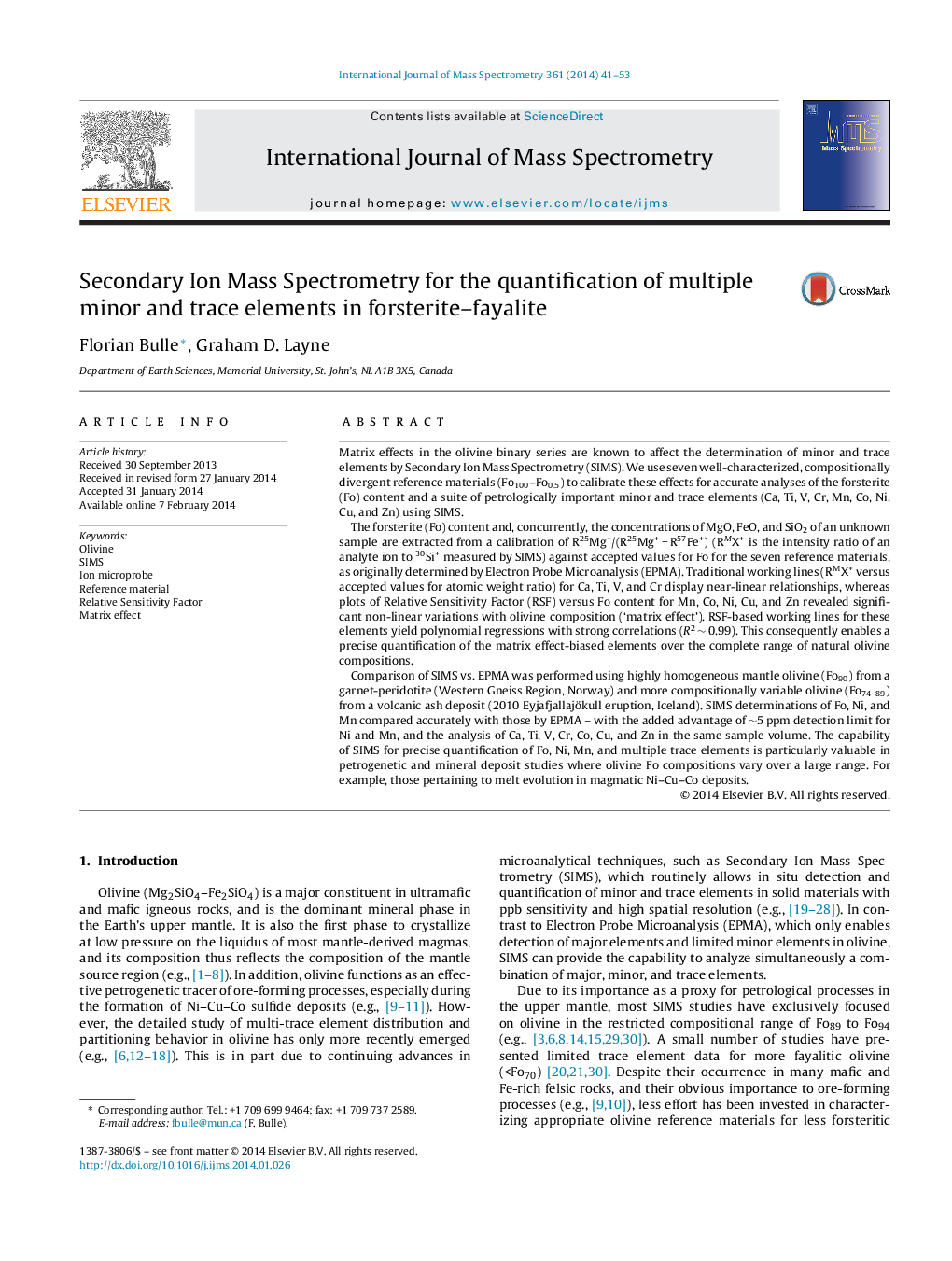| کد مقاله | کد نشریه | سال انتشار | مقاله انگلیسی | نسخه تمام متن |
|---|---|---|---|---|
| 1193244 | 1492266 | 2014 | 13 صفحه PDF | دانلود رایگان |
• We propose a refined approach for routine SIMS analysis and quantification of Mg, Ca, Ti, V, Cr, Mn, Fe, Co, Ni, Cu, and Zn in forsterite–fayalite.
• Seven Mg- and Fe-rich olivine samples were characterized and a subset was used as reference materials to determine matrix effect-corrected element concentrations.
• SIMS matrix effects most strongly affect predominantly bivalent transition metals (Mn, Co, Ni, Cu, and Zn) in high-Fe olivine.
• Trial runs of two unknown, chemically variable olivine populations yield comparable major and minor element data (Mg, Fe, Ni, and Mn) with SIMS and EPMA.
Matrix effects in the olivine binary series are known to affect the determination of minor and trace elements by Secondary Ion Mass Spectrometry (SIMS). We use seven well-characterized, compositionally divergent reference materials (Fo100–Fo0.5) to calibrate these effects for accurate analyses of the forsterite (Fo) content and a suite of petrologically important minor and trace elements (Ca, Ti, V, Cr, Mn, Co, Ni, Cu, and Zn) using SIMS.The forsterite (Fo) content and, concurrently, the concentrations of MgO, FeO, and SiO2 of an unknown sample are extracted from a calibration of R25Mg+/(R25Mg+ + R57Fe+) (RMX+ is the intensity ratio of an analyte ion to 30Si+ measured by SIMS) against accepted values for Fo for the seven reference materials, as originally determined by Electron Probe Microanalysis (EPMA). Traditional working lines (RMX+ versus accepted values for atomic weight ratio) for Ca, Ti, V, and Cr display near-linear relationships, whereas plots of Relative Sensitivity Factor (RSF) versus Fo content for Mn, Co, Ni, Cu, and Zn revealed significant non-linear variations with olivine composition (‘matrix effect’). RSF-based working lines for these elements yield polynomial regressions with strong correlations (R2 ∼ 0.99). This consequently enables a precise quantification of the matrix effect-biased elements over the complete range of natural olivine compositions.Comparison of SIMS vs. EPMA was performed using highly homogeneous mantle olivine (Fo90) from a garnet-peridotite (Western Gneiss Region, Norway) and more compositionally variable olivine (Fo74–89) from a volcanic ash deposit (2010 Eyjafjallajökull eruption, Iceland). SIMS determinations of Fo, Ni, and Mn compared accurately with those by EPMA – with the added advantage of ∼5 ppm detection limit for Ni and Mn, and the analysis of Ca, Ti, V, Cr, Co, Cu, and Zn in the same sample volume. The capability of SIMS for precise quantification of Fo, Ni, Mn, and multiple trace elements is particularly valuable in petrogenetic and mineral deposit studies where olivine Fo compositions vary over a large range. For example, those pertaining to melt evolution in magmatic Ni–Cu–Co deposits.
Figure optionsDownload high-quality image (176 K)Download as PowerPoint slide
Journal: International Journal of Mass Spectrometry - Volume 361, 15 March 2014, Pages 41–53
